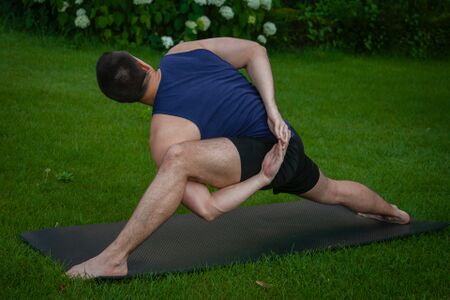Flexibility
Original Editor - Lucinda hampton
Top Contributors - Lucinda hampton, Anne Dixie Lim and Aminat Abolade
Introduction[edit | edit source]
General flexibility is a key component of health, well-being, and general physical conditioning. Reduced flexibility has both physical and mental/emotional etiologies and can lead to musculoskeletal injuries and athletic underperformance.[1]
Flexibility is operationally defined as “the intrinsic property of body tissues, including muscle and connective tissues that determines the range of motion achievable without injury at a joint or group of joints.” Flexibility is highly specific to each joint.
- Stretching exercises are typically performed to increase flexibility and to allow improved joint range of motion.
- Common forms of stretching include static stretch (passive and active), proprioceptive neuromuscular facilitation, ballistic stretch, and dynamic stretch. Other forms of physical activity that require stretching of the MTU (e.g., gymnastics, dance) can also result in improved flexibility. [2]
Warm Up[edit | edit source]
When preparing the muscles for action, eg swimming, running, you need to prepare your muscles. Warm ups typically include stretching. Traditionally, there have been two primary ways to do that: static stretching and active warm-up exercises.
A 2014 systematic review of 31 studies published in the British Journal of Sports Medicine found that active warm-ups encompassing such exercises as sprints and plyometrics can enhance power and strength performance. Meanwhile shorter, static stretching not only fails to provide such a boost, but may also reduce strength. A meta-analysis of 32 studies on warming up and performance in 2010 also found that doing an active warm-up before engaging in sports yields improved performance — in this case, by 79 percent across all criteria examined[3].
Sub Heading 3[edit | edit source]
Resources[edit | edit source]
- bulleted list
- x
or
- numbered list
- x
References[edit | edit source]
- ↑ Jensen AM, Ramasamy A, Hall MW. Improving General Flexibility with a Mind-Body Approach: A Randomized, Controlled Trial Using Neuro Emotional Technique®. The Journal of Strength & Conditioning Research. 2012 Aug 1;26(8):2103-12. Available:https://pubmed.ncbi.nlm.nih.gov/22814766/ (accessed 24.12.2021)
- ↑ Pate R, Oria M, Pillsbury L. Health-related fitness measures for youth: flexibility. InFitness Measures and Health Outcomes in Youth 2012 Dec 10. National Academies Press (US). Available:https://www.ncbi.nlm.nih.gov/books/NBK241323/ (accessed 24.12.2021)
- ↑ Open fit Dynamic vs Static stretching Available: https://www.openfit.com/dynamic-vs-static-stretching-warm-up-exercises(accessed 24.12.2021)







